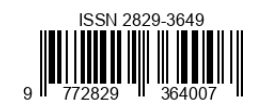Self-Presentation of Cashless Users through OVO E-Wallet (Study on Students of PGRI University Palembang)
DOI:
https://doi.org/10.56910/literacy.v2i2.954Keywords:
Student, self-presentation, self-concepts, Lifestyle, CashlessAbstract
This article examined how self-presentation was presented by cashless users through OVO e-wallet for student in PGRI Palembang. This research used descriptive qualitative method. Data collection techniques used by author were observation in PGRI University, interview with user OVO and did documentation when student used OVO. The author found the background of PGRI student was using OVO including policies regarding cashless, personal choices and social environment. This article used self-presentation theory by Erving Goffman to analyze PGRI student self-concepts in using OVO. As the results, this study has been shown that student display slang self-concepts such as student was hanging out in cafes and malls, contemporary self-concepts such as student was paying for all types of entertainment using OVO payment applications and socialite self- concepts such as student was buying clothes and accessories to support their appearance in front of his friends. It reflects that student adopt urban and hedonistic lifestyles when using OVO so that the assessment of their peers considers that students who are just hanging out for chasing discounts, current students are actually consumptive and socialite student are only for social climbing in class.
References
Jurnal Ahuja, A., & Joshi, R. (2018). Customer Perception towards Mobile Wallet. IJRDO-Journal of Business Management, 4(1), 52–60. diakses pada 5 Januari 2019 pada pukul 15.32 WIB
Anggraini, R., & Soenhadji, I. M. (2016). Pengaruh Gaya Hidup dan Pemanfaatan Teknologi (E-Banking) Terhadap Kepemilikan Kartu Kredit Serta Dampaknya pada Sikap Pengguna. In Seminar Nasional Aplikasi Teknologi Informasi (SNATi) 2016 (pp. 1–5). Yogyakarta. diakses pada 8 Oktober 2018 pada pukul 16.32 WIB
Bagdare, S. (2018). Digital Payments and Consumer Buying Behavior in India. Indian Journal Of Applied Research, 8(11), 25–26. diakses pada 15 November 2019 pada pukul 13.22 WIB
Bank Indonesia. (2018). 20/6/PBI/2018. Indonesia. diakses pada 15 November 2018 pada pukul 15.56 WIB
Bank Indonesia. (2018). Jumlah Uang Elektronik Beredar. Bank Indonesia. Retrieved fromhttps://www.bi.go.id/id/statistik/sistempembayaran/uangelektronik/Contents/Jumlah Uang Elektronik.aspx diakses pada 14 Januari 2019 pada pukul 19.34 WIB
Capgemini, & Paribas BNP. (2018). World Payments Report 2018. Retrieved from https://worldpaymentsreport.co m/wp- content/uploads/sites/5/2018/1 0/World-Payments-Report- 2018.pdf diakses pada 28 Desember 2018 pada pukul 14.40 WIB
DailySocial.id. (2018). Fintech Report 2018. Jakarta. diakses pada 19 Desember 2018 pada pukul 13.12 WIB
Economist, T. (2014, September). Mobile Money in Developing Countries. Retrieved. From.https://www.economist.com/economic-and-financial indicators/2014/09/20/mobile-money-in-developing-countries diakses pada 28 Januari 2019 pada pukul18.17 WIB
Goeltom, M. S. (2007). 9/15/PBI/2007. Indonesia: Penggunaan Teknologi Informasi oleh Bank Umum. diakses pada 25 Januari 2019 pada pukul 13.58 WIB
Indonesia, B. (2009). 11/12/PBI/2009. Indonesia. diakses pada 28 Februari 2019 pada pukul 16.32 WIB
Juliastuti, A. D., Hasanah, N., & Faizah. (2016). Kepemilikan Kartu Pembayaran Elektronik Tidak Memoderasi Gaya Hidup Hedonis Terhadap Perilaku Impulse Buying. MEDIAPSI, 2(2), 1–7. diakses pada 29 Desember 2018 pada pukul 19.20 WIB
Maulinda, D. G. (2015). Analisis Trust dalam Penggunaan E- Money sebagai Teknologi Konsumsi : Studi Mengenai Pengguna E-Money Kelas Menengah-Atas dan Menengah- Bawah Mahasiswa Fakultas Ilmu Sosial dan Ilmu Politik Universitas Indonesia. Indonesian Journal of Sociology and Education Policy, 62–79. diakses pada 17 Desember 2018 pada pukul 14.40 WIB
Nugraheni, P. N. . (2003). Perbedaan Kecenderungan Gaya Hidup Hedonis Pada Remaja Ditinjau Dari Lokasi Tempat Tinggal. Universitas Muhammadiyah Surakarta. diakses pada 19 Juli 2019 pada pukul 12.23 WIB
Priyono, A. (2017). Analisis Pengaruh Trust dan Risk dalam Penerimaan Teknologi Dompet Elektronik Go-Pay. Jurnal Siasat Bisnis, 21(1), 88–106. https://doi.org/10.20885/jsb.vol 21.iss1.art6 diakses pada 10 Januari 2019 pada pukul 18.10 WIB
Rorong, M. J. (2018). The Presentation Of Self in Everyday Life: Studi Pustaka Dalam Memahami Realitas Dalam Perspektif Erving Goffman. Jurnal Oratio Directa, 1(2), 119–132.Retrieved from http://www.ejurnal.ubk.ac.id/in dex.php/oratio/article/downloa d/58/40 diakses pada 19 Desember 2019 pada pukul 16.33 WIB
Buku
Bungin, B. (2017). Metodologi Penelitian Kualitatif: Aktualisasi Metodologis ke Arah Ragam Varian Kontemporer (Edisi 11). Depok: Raja Grafindo Persada.
Chaney, D. (2004). Lifestyle Sebuah Pengantar Komprehensif. (I. S. Ibrahim, Ed.) (Edisi 1). Yogyakarta: Jalastra.
Cresswell, J. W. (2015). Research Design Pendekatan Kualitatif, Kuantitatif dan Mixed. (S. Z. Qudsy, Ed.) (Cetakan V). Yogyakarta: Pustaka Pelajar.
Denzin, N. K., & Lincoln, Y. S. (2009). Handbook of Qualitatif Research. (Saifuddun Zuhri Qudsy, Ed.) (Edisi 2). Yogyakarta: Pustaka Pelajar.
Miles, M. B., Huberman, A. M., & Saldaña, J. (2014). Qualitative Data Analysis: A Methods Sourcebook. (S. Helen, Ed.) (Edition 3). California: Sage Publication.
Moleong, L. (2016). Metodologi Penelitian Kualitatif. (I. Taufik,Ed.) (Edisi 35). Bandung: Remaja Rosdakarya.
Ritzer, G. (2012). Teori Sosiologi dari Sosiologi Klasik sampai PerkembanganTerakhir Postmodern. (W. A. Djohar, Ed.) (Edisi 8). Yogyakarta: Pustaka Pelajar.
Ritzer, G. (2014). Teori Sosiologi Dari Sosiologi Klasik Sampai Perkembangan Terakhir Postmodern. (W. A. Djohar, Ed.) (Edisi 2). Yogyakarta: Pustaka Pelajar.
Rokian, A. (2012). Kiprah Universitas PGRI Palembang. (Tobari, Ed.) (Edisi 1). Palembang: Universitas PGRI Palembang. Silalahi, U. (2009). Metode Penelitian Sosial. Bandung: PT Refika Aditama.
Internet
BeritaSatu.tv. (2017). OVO Perkenalkan Fitur-fitur Menarik ke Mahasiswa UPH Karawaci. Indonesia. Retrieved from http://www.beritasatu.tv/news/ovo-perkenalkan-fitur-fitur- menarik-ke-mahasiswa-uph- karawaci/ diakses pada 15 Januari 2019 pada pukul 13.24 WIB
Masassya, E. G. (2012). Masyarakat Tanpa Uang Tunai. Kompas.Com. Retrieved from https://lifestyle.kompas.com/re ad/2012/12/10/0946474/masya rakat.tanpa.uang.tunai diakses pada 13 Februari 2019 pada pukul 20.15 WIB Oxfordictionaries.com. (n.d.). Cashless. Retrieved from https://en.oxforddictionaries.co m/definition/cashless diakses pada 13 Januari 2019 pada pukul 14.19 WIB
Purwanti, J. (2018, November). Bank Mandiri Galakkan e-Money Lewat Generasi Milenial. Sripoku.Com. Retrieved from http://palembang.tribunnews.co m/2018/11/11/bank-mandiri- galakkan-e-money-lewat- generasi-milenial diakses pada 13 Januari 2019 pada pukul 14.19 WIB
Saifullah. (2019). Demi Tingkatkan Transaksi Nontunai, Ovo Kerja Sama Dengan Ubaya Dan UNS. Retrieved from https://www.nontunai.com/dem i-tingkatkan-transaksi- nontunai-ovo-kerja-sama- dengan-ubaya-dan-uns/ diakses pada 12 Januari 2019 pada pukul 11.40 WIB
Singh, S. (2017). Study of Consumer Perception of Digital Payment Mode. Journal of Internet Banking and Commerce, 22(3), 1–14. https://doi.org/10.1038/oby.20 10.174 diakses pada 18 Januari 2019 pada pukul 14.15 WIB







